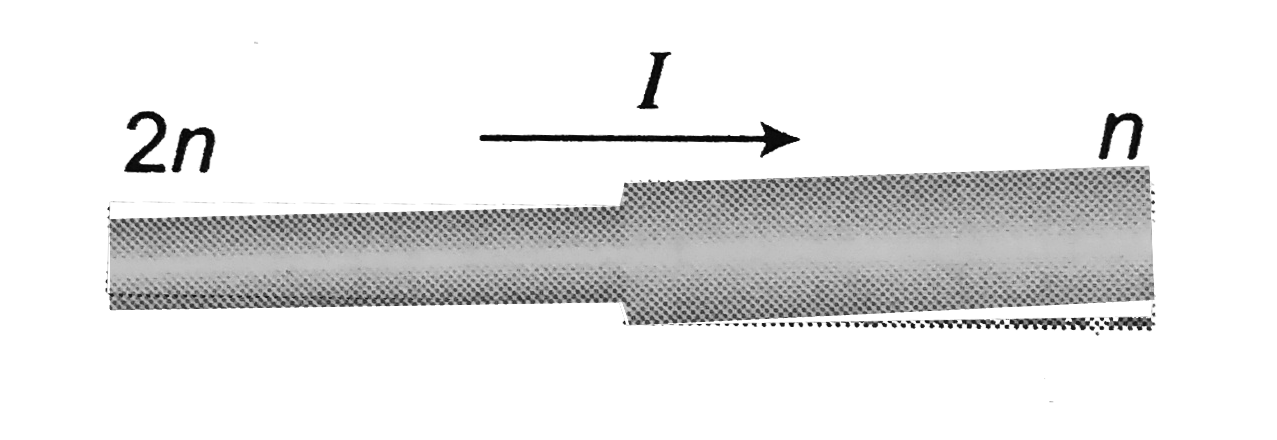When current flows through a conductor, then the order of drift velocity of electrons will be
1010cms−1
10−2cms−1
104cms−1
10−1cms−1
The correct Answer is:B
To determine the order of drift velocity of electrons when current flows through a conductor, we can follow these steps:
1. Understanding Drift Velocity:
- Drift velocity is the average velocity that a charge carrier, such as an electron, attains due to an electric field. It is typically very small compared to the random thermal velocities of electrons.
2. Order of Drift Velocity:
- The drift velocity of electrons in a conductor is generally of the order of 10−4 meters per second. This is a fundamental fact that can be found in textbooks on electricity and magnetism.
3. Conversion to Centimeters per Second:
- Since the question may require the answer in different units, we can convert the drift velocity from meters per second to centimeters per second.
- We know that 1 meter=100 centimeters. Therefore, to convert 10−4 m/s to centimeters per second:
10−4 m/s×100 cm/m=10−2 cm/s
4. Conclusion:
- Thus, the order of drift velocity of electrons in a conductor is 10−4 m/s or 10−2 cm/s.
Final Answer:
- The order of drift velocity of electrons when current flows through a conductor is 10−4 m/s or 10−2 cm/s.
---
- Drift velocity is the average velocity that a charge carrier, such as an electron, attains due to an electric field. It is typically very small compared to the random thermal velocities of electrons.
- The drift velocity of electrons in a conductor is generally of the order of 10−4 meters per second. This is a fundamental fact that can be found in textbooks on electricity and magnetism.
- Since the question may require the answer in different units, we can convert the drift velocity from meters per second to centimeters per second.
- We know that 1 meter=100 centimeters. Therefore, to convert 10−4 m/s to centimeters per second:
10−4 m/s×100 cm/m=10−2 cm/s
- Thus, the order of drift velocity of electrons in a conductor is 10−4 m/s or 10−2 cm/s.
- The order of drift velocity of electrons when current flows through a conductor is 10−4 m/s or 10−2 cm/s.
Topper's Solved these Questions
- CURRENT ELECTRICITYBOOK - DC PANDEY ENGLISHCHAPTER - CURRENT ELECTRICITYEXERCISE - Taking it together
142 Videos
- CURRENT ELECTRICITYBOOK - DC PANDEY ENGLISHCHAPTER - CURRENT ELECTRICITYEXERCISE - B. Assertion and reason
18 Videos
- CURRENT ELECTRICITYBOOK - DC PANDEY ENGLISHCHAPTER - CURRENT ELECTRICITYEXERCISE - Example
65 Videos
- COMMUNICATION SYSTEMBOOK - DC PANDEY ENGLISHCHAPTER - COMMUNICATION SYSTEMEXERCISE - Subjective
11 Videos
- ELECTROMAGNETIC INDUCTIONBOOK - DC PANDEY ENGLISHCHAPTER - ELECTROMAGNETIC INDUCTIONEXERCISE - Medical entrances gallery
25 Videos
Similar Questions
When a current passes through a resistor, its temperature increases. Is it an adiabatic process?
View SolutionWhen no current is passed through a conductor,
View SolutionWhen the current i is flowing through a conductor, the drift velocity is v . If 2i current is flowed through the same metal but having double the area of cross-section, then the drift velocity will be
View SolutionWhen the current i is flowing through a conductor, the drift velocity is v . If 2i current is flowed through the same metal but having double the area of cross-section, then the drift velocity will be
View SolutionTwo cylindrical rods of uniform cross-section area A and 2A, having free electrons per unit volume 2n and n respectively are joined in series. A current I flows through them in steady state. Then the ratio of drift velocity of free electron in left rod to drift velocity of electron in the
right rod is (vLvR) is

View SolutionThe current of a conductor following through a conductor in terms of the drift speed of electrons is (the symbols have their usual meanings)
View SolutionA conductor wire having 1029 free electrons /m3 carries a current of 20A. If the cross-section of the wire is 1mm2, then the drift velocity of electrons will be :
View Solution(a) Why do the 'free electrons' , in a metal wire , flowing by themselves' not cause any current flow in the wire ?
Define drift velocity' and obtain an expression for the current flowing in a wire, in terms of the 'drift velocity of the free electrons.
(b) Use the above expression to show that the 'resistivity ' of the material of a wire is inversely proportional to the 'relaxation time' for the 'free electrons ' in the metal.
View Solutionif E denotes electric field in a uniform conductor and vd the corresponding drift velocity of free electrons in the conductor, then which of the following graph is correct
View SolutionAssertion : Current flows in a conductor only when there is an external electric field within the conductor.
Reason: The drift velocity of the electrons is directly proportional to the electric field.
View Solution
